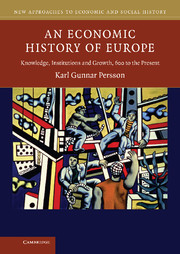Book contents
- Frontmatter
- Contents
- List of tables
- List of figures
- List of maps
- List of boxes
- Foreword
- Introduction: What is economic history?
- 1 The making of Europe
- 2 Europe from obscurity to economic recovery
- 3 Population, economic growth and resource constraints
- 4 The nature and extent of economic growth in the pre-industrial epoch
- 5 Institutions and growth
- 6 Knowledge, technology transfer and convergence
- 7 Money, credit and banking
- 8 Trade, tariffs and growth Karl Gunnar Persson and Paul Sharp
- 9 International monetary regimes in history by Karl Gunnar Persson and Paul Sharp
- 10 The era of political economy: from the minimal state to the Welfare State in the twentieth century
- 11 Inequality among and within nations: past, present, future
- 12 Globalization and its challenge to Europe
- Glossary by Karl Gunnar Persson and Marc P. B. Klemp
- Index
12 - Globalization and its challenge to Europe
- Frontmatter
- Contents
- List of tables
- List of figures
- List of maps
- List of boxes
- Foreword
- Introduction: What is economic history?
- 1 The making of Europe
- 2 Europe from obscurity to economic recovery
- 3 Population, economic growth and resource constraints
- 4 The nature and extent of economic growth in the pre-industrial epoch
- 5 Institutions and growth
- 6 Knowledge, technology transfer and convergence
- 7 Money, credit and banking
- 8 Trade, tariffs and growth Karl Gunnar Persson and Paul Sharp
- 9 International monetary regimes in history by Karl Gunnar Persson and Paul Sharp
- 10 The era of political economy: from the minimal state to the Welfare State in the twentieth century
- 11 Inequality among and within nations: past, present, future
- 12 Globalization and its challenge to Europe
- Glossary by Karl Gunnar Persson and Marc P. B. Klemp
- Index
Summary
Globalization and the law of one price
The hype around globalization in early twenty-first century political and economic debates may convey an impression that we now are in an entirely new phase of economic development. This chapter will show that the presumption is wrong. A dose of elementary economic history is often helpful when the popular media forget about the past.
Globalization is market integration on a world scale. Market integration means that domestic markets are increasingly dependent on international markets. Prices and hence factor rewards will reflect global rather than local demand and supply conditions. Globalization is the product of intensified trade, capital mobility and migration. In that process prices, interest rates and sometimes wages tend to converge and react faster to international shocks. The first wave of globalization started in the middle of the nineteenth century when barriers to trade, migration and capital mobility were abolished or weakened at the same time as the speed of information transmission increased. In most respects markets were as globalized around 1900 as they were at the beginning of the present century. In fact labour mobility across borders was less restricted before 1914 than it is now. However, there was an anti-globalization backlash early in the twentieth century with two World Wars and the Great Depression. That policy reversal affected commodity, labour and capital markets to the extent that the late nineteenth-century globalization level was not regained until the 1970s or 1980s, when the second globalization period gained momentum.
- Type
- Chapter
- Information
- An Economic History of EuropeKnowledge, Institutions and Growth, 600 to the Present, pp. 221 - 241Publisher: Cambridge University PressPrint publication year: 2010

